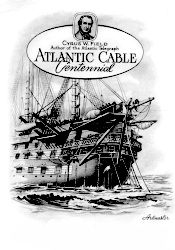![]()
|
|
|
|
|
|||||

Success Stories
Transatlantic Cable Communications
Canso, Nova Scotia: Home of the Original Information Highway
 Many
Canadians may be unaware that this country entered the Information Age
years ahead of most of the rest of the world when the tiny fishing village
of Canso, Nova Scotia became the landing site for one of the first transatlantic
telegraph cables from Europe to North America in 1881.
Many
Canadians may be unaware that this country entered the Information Age
years ahead of most of the rest of the world when the tiny fishing village
of Canso, Nova Scotia became the landing site for one of the first transatlantic
telegraph cables from Europe to North America in 1881.
The project was carried out under contract to Industry Canada’s SchoolNet Digital Collections program, which gives people 15 to 30 years of age entrepreneurial and technology-based job experience converting collections of Canadian material into digital form for display on SchoolNet. The SchoolNet Digital Collections web site has grown to become possibly the largest single source of Canadian content on the Information Highway.
The story of the "original Information Highway" is a fascinating piece of little-known Canadiana and the web site is impressive. It tells the story of Canso and its neighbouring village, Hazel Hill, in detail that remains fresh and interesting because it is told from various different points of view. Depending on your interests, you can approach Canso’s story from the earliest days of recorded history in the area, and learn how it fits in with the great scientific discoveries of the time. For example, the site describes the invention of the telegraph, and outlines the enormous difficulties of laying miles of transatlantic cable in stormy, dangerous seas.
For browsers interested in technical information, the site offers photos and descriptions of the "tools of the trade". Those who enjoy history are in for a rare treat as the site recalls the people, places and events that made the cable story. For the tourist in all of us, photographs of Canso and surrounding areas capture the rugged beauty of the Nova Scotia coast. And for the just plain curious, interesting and little known facts abound. For example, did you know that it was a Canadian who received the first news about the sinking of the Titanic?
Troy Greencorn, project leader of the Transatlantic Cable Communications story, is Deputy Town Clerk for the Town of Canso and operates a computer training centre and computer consulting company. He’s enthusiastic about the many advantages the project had for Canso. "Because of this and another subsequent Digital Collections project, Canso has taken a lead role in Nova Scotia in getting the community up and running on the Information Highway," he says. "It also gave us the impetus to write our own history." Greencorn notes that everyone in Canso is very aware of their unique traditions in communications. "We are surrounded by history, but we never took the time to actually record it anywhere. Now it’s on the Internet."
Greencorn says it’s fitting that Canso should be taking a lead role in helping Nova Scotia go on-line. "Technology and communications are as much a part of our tradition as the fishing industry," he notes. "Our municipal office is housed in the old Western Union building. The old cables still come through the basement. It’s ironic that 115 years later MTT (Maritime Telephone and Telecommunications) came in here to connect us to the Internet."
Greencorn credits the success of the cable communications site to the three Canso residents who researched, developed and digitized it.
Martha Kavanaugh’s historical expertise was invaluable. As a member of the Canso Historical Society and curator for the Whitman House Museum for over ten years, she feels that the project gave her solid computer skills and experience.
Local entrepreneur Bill MacMillan owns a campground in nearby Fox Island, one of the main landing sites for the cables into Canso. As a result of his experience with the project, he was one of the first local businesses to hook into the Community Information Network and develop a web page for his business.
Velda Richardson found she had an affinity for web programming, and after the cable communications project she started a job at the Canso Historical Society creating a genealogy database and developing a virtual tour of the local museum.
|
Updated: |